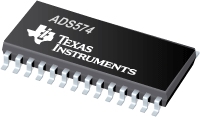Microprocessor-Compatible Sampling CMOS A/D Converter 28-SOIC
PDF, 69 Kb, Revision: A, File published: May 18, 2015
PDF, 54 Kb, File published: Sep 27, 2000
This application note compares basic current-mode successive approximation A/Ds with CDAC-based architectures, and shows how adding a resistor divider network to the CDAC input permits the Burr-Brown ADS574 and ADS774 to fit existing ADC574 sockets. It then goes on to descibe some new analog input voltage ranges available on these parts due to the resistor network and CDAC approach.
PDF, 425 Kb, Revision: B, File published: Oct 9, 2011
This glossary is a collection of the definitions of Texas Instruments' Delta-Sigma (О”ОЈ), successive approximation register (SAR), and pipeline analog-to-digital (A/D) converter specifications and performance characteristics. Although there is a considerable amount of detail in this document, the product data sheet for a particular product specification is the best and final reference.
PDF, 64 Kb, File published: Oct 2, 2000
It is tempting when pushing the limits of analog-to-digital conversion to consider interleaving two or more converters to increase the sample rate. However, such designs must take into consideration several possible sources of error.
PDF, 68 Kb, File published: Oct 2, 2000
The CMOS ADS574 and ADS774 are drop-in replacements for industry standard ADC574 analog-to-digital converter, offering lower power and the capability to operate from a single +5V supply. The switched capacitor array architecture (CDAC), with the input resistor divider network to provide ADC574 input ranges, also allow the new parts to handle additional input ranges, including a 0V to 5V range. Thi
PDF, 227 Kb, Revision: A, File published: Nov 10, 2010
This application report analyzes a simple method for calculating minimum acquisition times for successive-approximation register analog-to-digital converters (SAR ADCs). The input structure of the ADC is examined along with the driving circuit. The voltage on the sampling capacitor is then determined for the case when a step function is applied to the input of the driving circuit. Three different
PDF, 95 Kb, File published: Oct 2, 2000
Exactly how inaccurate will a change in temperature make an analog-to-digital or digital-to-analog converter? As designers are well aware, a 12-bit device may provide a much lower accuracy at its operating-temperature extremes, perhaps only to 9 or even 8 bits. But for lack of more precise knowledge, many play it safe (and expensive) and overspecify.
PDF, 132 Kb, Revision: A, File published: Apr 16, 2015
PDF, 215 Kb, File published: Mar 17, 2011
The input structure circuit of a successive-approximation register analog-to-digital converter (SAR ADC) incombination with the driving circuit forms a transfer function that can be used to determine minimum acquisition times for different types of applied input signals. This application report, which builds on Determining Minimum Acquisition Times for SAR ADCs When a Step Function is Applied to

